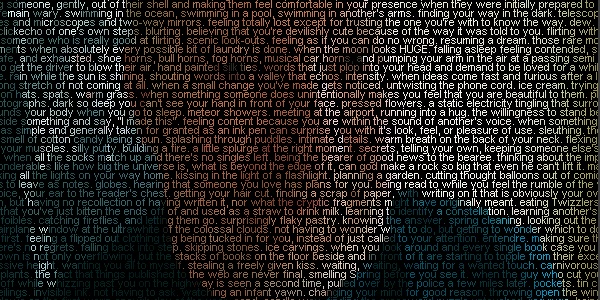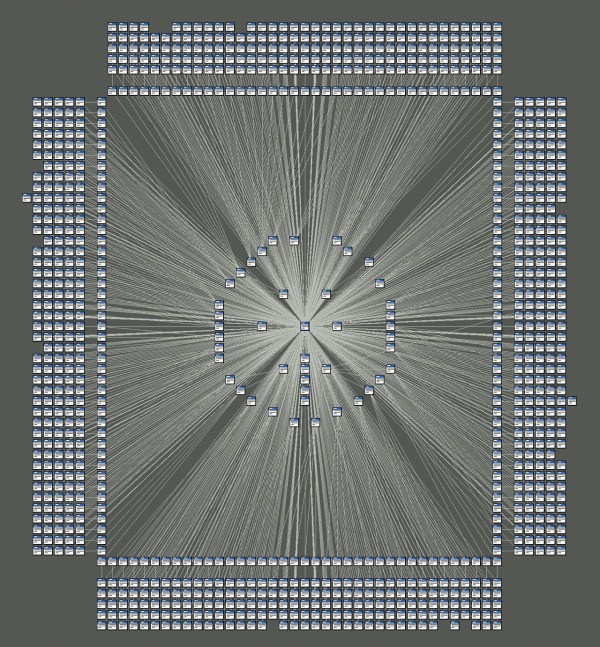A Story About A Story About Stories
"If I say I made a game I get READ"
The Kiss creator and poet Dan Waber wrote to me and Porpentine with a very personal story about how the games community, specifically the Twine community and RPS readers, have embraced him more forcefully than the literature community has. I was quite moved by his candour in talking about his newest readers, and I asked him if I could publish his letter here. He said yes. Here are his words.
In 2010 I was noodling around with a free tool for creating hypertext stories and interactive fictions called Twine when I had an idea for a piece that would be perfect to make with it.
Early on in the process I started to experience some very difficult to deal with slowdowns from the visual editor so I contacted the author of the software, Chris Klimas, who was extremely helpful. After sending him my working file to demonstrate what I was experiencing he made some changes to the software to improve the situation, and made a suggestion for a MUCH better way to structure the map. The way was so much better that I am not sure I would have been able to finish what became a novel-length text if it had been structured differently. I had started with what was basically a top-down hierarchical tree, and he suggested a beginning-in-the-center shape, which crystallized my hazy plan perfectly. During one later exchange he told me that he was pretty sure it was the largest project anyone had attempted with Twine.
So when I got this novel-length hypertext finished, completely proofed and corrected and ready for the world I wasn't sure what to do with it. I'm kind of a control freak when it comes to the presentation of my work, and I'd recently had yet another very dissatisfying episode dealing with someone else publishing something of mine, so I said you know what, screw it, I'm going to publish it myself at my website logolalia.com and I'll post a screen capture of the whole map, and write an introduction to it, and then put it behind a very small pay-wall. $5. Well, not all experiments work. Two people in the first week and none in the two years that followed. Pretty bleak.
Then in 2012 I got a very kind invitation from an online literary journal to send work for their soon-to-launch next issue. I've had a couple of things published there in the past, and they've always been very supportive of the electronic literature community, so I offered them this piece. The issue that it appears in came out in June. Here's where it starts to get numerically interesting.
One thing that I added to the Twine code is some tracking code that shows me in real time when people are visiting which pages. When I gave the file to the journal I figured they would probably comb through the code in order to change the visual look of the piece to match their issue and figured there was a decent chance that tracking code wouldn't make it into the final version that went online. However, what they did was make a frame on the page that loads my original from my site.
So I was able to watch, in real time, how many people were reading this piece, and for how long. I also have my server logs to reference the aggregate numbers. I looked at this as a fun experiment in traffic watching. That journal has about 7200 Twitter followers. I don't know their Facebook numbers because I refuse to use Facebook.
Then, about a week later, because I had contributed some columns to their e-issues, a well-respected print poetry journal sent out a tweet linking directly to my piece in the issue, not to the issue in general. They have about 5600 followers. There's bound to be some overlap, of course, but just for roundness, let's say that's 10,000 people who saw tweets about the issue launch, or my piece directly.
It was fun to watch people visit, watch the time they stayed, and how many pages they read. The piece has 1001 passages, but most people viewed just a tiny fraction of them. I thought, man, I am a crappy writer, I guess. Now, to be fair, some people engaged with the work, and my wife read to me an interesting discussion that happened on Facebook among some Canadian writers we know and some we don't, but--and I wasn't keeping super-strict check on it (and I only watch from 8-5 my time, so have NO idea what happened off hours)--my general impression was that it was being briefly considered. I think the most pages I saw any one person view was in the teens. Hardly anyone stayed with it for longer than a few minutes.
Then I was AFK for a week on vacation.
Then, something really fun happened. I learned that there's a lot of people out there who use Twine to make text-based games. I saw one tweet from one gamer blossom in about two weeks. At first they came to visit in numbers about twice what I'd seen from the literary communities, then Porpentine posted a link to it on freeindiegam.es (http://www.freeindiegam.es/2013/07/a-kiss-dan-waber/), and someone else commented that SURELY it hadn't been made in the Twine GUI, so I posted a reply saying it had been, along with a link to the node-map, which Porpentine posted to a collection of Twine node maps and then wrote a review of the piece, as a game, on RPS.
The traffic from that is just now starting to die down, and this is what I learned by watching in real time and reviewing server logs.
In June, when the issue launched, and the literary announcements went out, the file that is my story was loaded n times.
In July, as of yesterday, the file was loaded 10*n times. By this time the literary journal accounted for 0.3*n. The rest were from the gaming community who linked to my original file, not to the journal, which is what made these differences see-able to me. 5*n visitors were the result of Porpentine's review at RPS.
But the really cool part is how much more time people who approached it as a "game" spent than people who approached it as "literature". The game community page numbers were consistently in the 50-70 page range, and the highest individual number I saw was 104, by a person with a Munich IP address who spent 4 hours with it. There are some people who haven't left it. They have simply kept it open in their browsers and once a day for the past week they add a couple of pages to their total count.
It's enough to make a poet start calling himself a game developer. Because it really seems like if I call a thing I did a poem people say "that's nice, dear" and pat me on the head like I'm precious. If I say I made a game I get READ.
Regards,
Dan
Thank you Dan. You can play The Kiss here.






